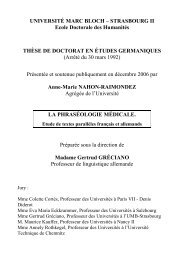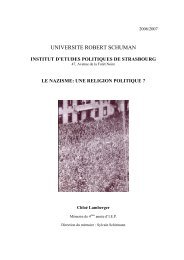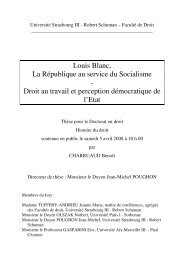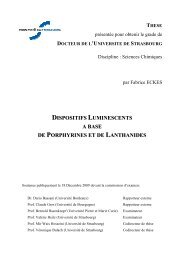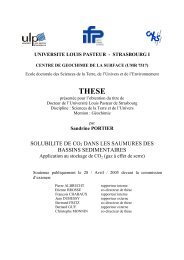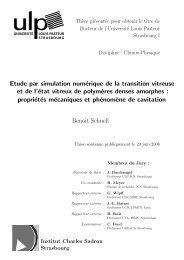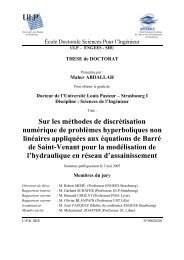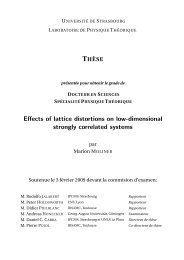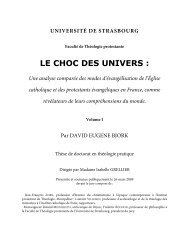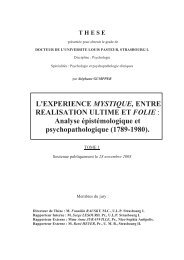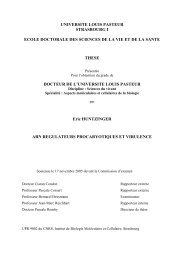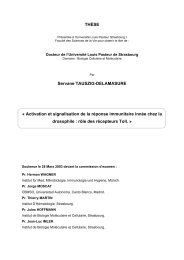- Page 1 and 2: THESE Présentée à l’Universit
- Page 3 and 4: Lisa, Mireia, Anja, Fredy, Shuanmin
- Page 5 and 6: SOMMAIRE Composition du document et
- Page 7 and 8: 6. reference 32 Chapitre V Synthesi
- Page 9 and 10: Composition du document et organisa
- Page 11 and 12: Introduction La dynamique économiq
- Page 13 and 14: Introduction La première étape co
- Page 15 and 16: Introduction 26, 68-70 Des mécanis
- Page 17 and 18: R R' P Ni Ph O B(Arf) R = R' = t-Bu
- Page 19 and 20: Introduction Activés par des alkyl
- Page 21 and 22: 18 19 20 21 22 23 24 25 26 27 28 29
- Page 23 and 24: 88 89 90 91 92 93 94 95 96 97 98 99
- Page 25 and 26: Chapitre I Nickel Complexes with Fu
- Page 27 and 28: Abstract Chapitre I Zwitterionic N,
- Page 29 and 30: R HN O 1 O NH R Ph Ph 3P Ni R N O 2
- Page 31: Chapitre I As shown in Figure 1, th
- Page 35 and 36: Chapitre I Figure 6. View of the ar
- Page 37 and 38: Chapitre I with the metal, 51-54 tw
- Page 39 and 40: Chapitre I these conditions, precat
- Page 41 and 42: Chapitre I The precatalyst 13-17 ha
- Page 43 and 44: Chapitre I Table 5. Catalytic Data
- Page 45 and 46: TOF mol C2H4 / mol Ni.h -1 20000 15
- Page 47 and 48: Chapitre I (s, OCH2), 81.27 (s, N
- Page 49 and 50: Chapitre I atoms introduced as fixe
- Page 51 and 52: Chapitre I (51) Tempel, D. J.; Broo
- Page 53 and 54: Abstract Chapitre II The dinuclear
- Page 55 and 56: Chapitre II Other neutral nickel co
- Page 57 and 58: OH 4 O N 4 13 OH N + 2 NiCl 2 + 2 N
- Page 59 and 60: N2-Ni1-Cl1 169.45(12) 89.35(15) N2-
- Page 61 and 62: Table 2. Selected bond distances an
- Page 63 and 64: Chapitre II solubility of 15 in chl
- Page 65 and 66: Chapitre II Table 4. Catalytic Data
- Page 67 and 68: Chapitre II Table 5. Comparative Ca
- Page 69 and 70: mass % of C4 olefins 100 90 80 70 6
- Page 71 and 72: 5. Experimental Chapitre II The 1 H
- Page 73 and 74: Chapitre II a dark green powder. Yi
- Page 75 and 76: Chapitre II 17 W. Keim, J. Mol. Cat
- Page 77 and 78: 7. Supporting information Table S1.
- Page 79 and 80: Chapitre III Unprecedented Tetranuc
- Page 81 and 82: Abstract Chapitre III Reactions of
- Page 83 and 84:
Chapitre III distorted octahedral c
- Page 85 and 86:
data for 2a⋅2CH2Cl2: 1.41 and for
- Page 87 and 88:
Chapitre III indicate that subtle d
- Page 89 and 90:
SUPPORTING INFORMATION FOR Chapitre
- Page 91 and 92:
Chapitre III by filtration. The sol
- Page 93 and 94:
Chapitre III 4 was prepared followi
- Page 95 and 96:
[S- ] 3. Evans method 2 Chapitre II
- Page 97 and 98:
Chapitre III Application Constructe
- Page 99 and 100:
Chapitre III [S-5] J. K. McCusker,
- Page 101 and 102:
Abstract Chapitre IV The P,N-type l
- Page 103 and 104:
Chapitre IV Scheme 1. Complexes wit
- Page 105 and 106:
12 PPh 2 N O N PPh 2 O N 13 P 14 15
- Page 107 and 108:
Chapitre IV Although some nickel co
- Page 109 and 110:
Scheme 2. Representation of the squ
- Page 111 and 112:
Chapitre IV The analysis of the dif
- Page 113 and 114:
Chapitre IV Table 4. Catalytic Data
- Page 115 and 116:
mass % of 1-butene 100 90 80 70 60
- Page 117 and 118:
Chapitre IV Table 6. Catalytic Data
- Page 119 and 120:
ef Scheme 3. Proposed pathways to e
- Page 121 and 122:
4. Conclusion Chapitre IV New P,N l
- Page 123 and 124:
Chapitre IV SiCH3), 30.25 (s, SiCH2
- Page 125 and 126:
Chapitre IV 122.3 (s, Py), 122.5 (d
- Page 127 and 128:
[Ni(µ-Cl)2{(pyridin-2-yl) methanol
- Page 129 and 130:
Chapitre IV mmol of Ni complex or 1
- Page 131 and 132:
6. References (1) Ziegler, K.; Holz
- Page 133 and 134:
Chapitre IV (44) Bluhm, M. E.; Foll
- Page 135 and 136:
Chapitre V Synthesis and catalytic
- Page 137 and 138:
Chapitre V to 16, the IR spectrum o
- Page 139 and 140:
Chapitre V activated by MAO (Scheme
- Page 141 and 142:
2 OH N + PPhCl 2 NEt 3 - (HNEt 3)Cl
- Page 143 and 144:
Chapitre V Slow diffusion of heptan
- Page 145 and 146:
Chapitre V Figure 3. ORTEP view of
- Page 147 and 148:
Chapitre V tridentate ligand but wi
- Page 149 and 150:
Chapitre V spin system 1) and 3.06
- Page 151 and 152:
Chapitre V This establishes the coo
- Page 153 and 154:
TOF (mol C2H4/(mol Ni.h)) 90000 800
- Page 155 and 156:
% mass of 1-butene 80 70 60 50 40 3
- Page 157 and 158:
Chapitre V cyclic voltammograms of
- Page 159 and 160:
Chapitre V A n-BuLi solution (64.0
- Page 161 and 162:
Chapitre V IR (KBr): 1658 (vs), 147
- Page 163 and 164:
Chapitre V To a solution of (2-oxaz
- Page 165 and 166:
Chapitre V Synthesis of [Co{bis(1-(
- Page 167 and 168:
Chapitre V 30 bar working pressure
- Page 169 and 170:
6. References 1 2 3 4 5 6 7 8 9 10
- Page 171 and 172:
67 68 69 70 71 72 73 74 75 76 77 78
- Page 173 and 174:
Abstract Chapitre VI The β-keto ph
- Page 175 and 176:
Ph O 3 toluene PPh3 + Ni(COD) 2 + P
- Page 177 and 178:
Chapitre VI The synthesis of β-ket
- Page 179 and 180:
Table 1 Selected bond distances (Å
- Page 181 and 182:
Ph O toluene PR2R' + Ni(COD) 2 + C5
- Page 183 and 184:
4. Conclusion Chapitre VI The β-ke
- Page 185 and 186:
Chapitre VI and the solution was st
- Page 187 and 188:
Chapitre VI (s, p-C of OC-Ph), 131.
- Page 189 and 190:
Chapitre VI To a solution of 13.000
- Page 191 and 192:
Chapitre VI the solvents under redu
- Page 193 and 194:
Chapitre VI Crystal Structure Deter
- Page 195 and 196:
23 F. A. Hicks and M. Brookhart, Or
- Page 197 and 198:
Chapitre VII Réarrangement type Ar
- Page 199 and 200:
1. Introduction Chapitre VII Brookh
- Page 201 and 202:
N OPPh 2 OPPh 2 + NiCl2(DME) N O Ph
- Page 203 and 204:
Chapitre VII mécanisme apparenté
- Page 205 and 206:
[Ni{2,6-bis((diphenylphosphinito)me
- Page 207 and 208:
Résumé et Conclusion générale
- Page 209 and 210:
Chapitre II Résumé et conclusion
- Page 211 and 212:
Résumé et conclusion générale P
- Page 213 and 214:
Résumé et conclusion générale l
- Page 215 and 216:
Chapitre VII Résumé et conclusion



